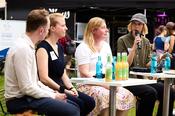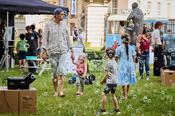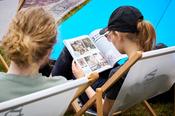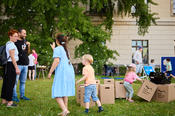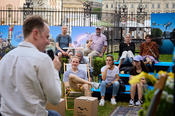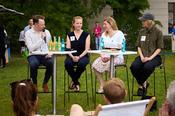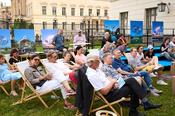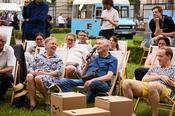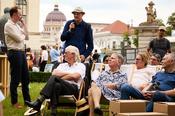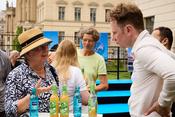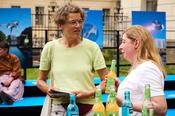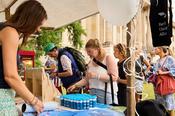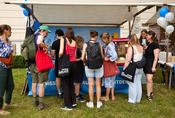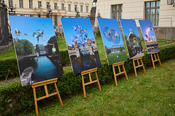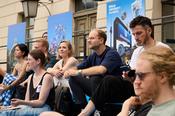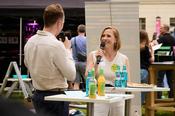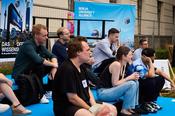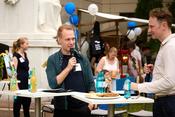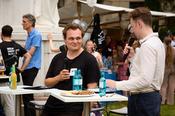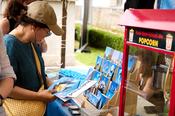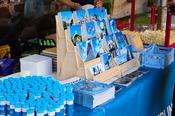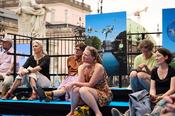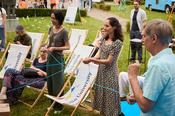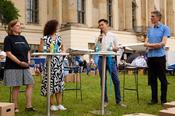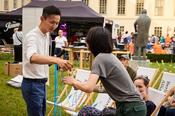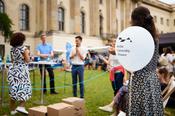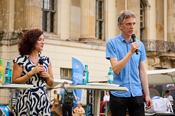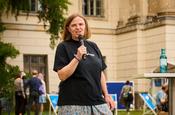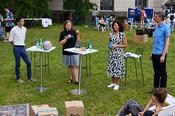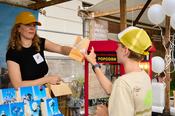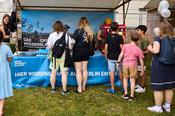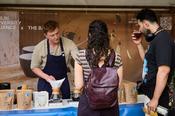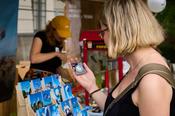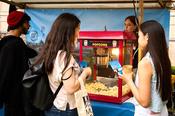THE OPEN LAB at the Long Night of Science 2025
On June 28, THE OPEN LAB presented itself in all its diversity. For the Long Night of Science, around 50 Berlin scientific institutions opened their doors and made research accessible to everyone. Over 36,000 visitors took advantage of the opportunity—including the Berlin University Alliance, which offered a varied program in the courtyard of Humboldt University.
Exchange on the major issues of our time
Visitors were able to engage directly with scientists on the BUA platform in front of the main building of HU Berlin. Three program items focused on the question of how research can contribute to solving global challenges:
- The event kicked off with a special edition of the BUA Open Space salon series on the topic of water.
- This was followed by the winners of the “Art Meets Science” ideas competition presenting their projects, accompanied by an exhibition of artistic interpretations of their research.
- The event concluded with concise pitches from three Berlin clusters of excellence, which provided insights into their cutting-edge research.
Popcorn, BUA coffee from The Barn, and many stimulating conversations created the perfect atmosphere.
Magazine premiere: “beyond”
The Berlin University Alliance's new magazine, beyond, was unveiled for the first time. Created in cooperation with the Tagesspiegel newspaper, the title stands for research that transcends boundaries—academic, institutional, and sectoral.
“Water for everyone?” – a special edition of the BUA Open Space series
We take water coming out of the tap for granted – but for how much longer? Resources are becoming scarcer in Berlin and the surrounding area too: less rain, falling groundwater levels, and growing demand from the population, industry, and agriculture are putting pressure on the system.
At BUA OPEN SPACE during the Long Night of Science, we invited our audience to discuss the future of water in Berlin with researchers and stakeholders from politics and culture.
Who was there?
The panel included Prof. Dr. Irina Engelhardt, hydrogeologist at TU Berlin, Frauke Bathe, head of the Water Management and Geology Department at the Berlin Senate Administration, and Dr. Anna-Lisa Dieter, curator at Humboldt Labor. The discussion was moderated by Mads Pankow.
Brandenburg – a problematic case
Right at the start, Irina Engelhardt made it clear that Brandenburg is particularly badly affected. The region has comparatively low rainfall, a dry, continental climate, high summer temperatures – and high evaporation due to the evergreen coniferous forests. As a result, water is a structurally scarce commodity here.
Water, society, and culture
Dr. Anna-Lisa Dieter drew attention to the social and cultural dimensions of the water issue. She spoke about the tension between science and activism—a topic that also plays a role in the upcoming exhibition “on water. WasserWissen in Berlin", which opens October, 10th 2025 at the Humboldt Forum.
How does the city of Berlin take action?
Frauke Bathe described the current strategy of the Berlin administration: the focus is currently on communication, not regulation. But public pressure is growing – as evidenced by the lively participation from the audience.
Art meets science
What is your idea for the major transformations of our time? This question was the focus of the Berlin University Alliance's “Art Meets Science” ideas competition – and it was answered during the Long Night of Science: in an exhibition and a talk, the winners of the competition presented their projects and their artistic interpretations.
Making the invisible visible
To kick things off, Claudio Rimmele, founder of the Observism agency and creative director of the THE OPEN LAB campaign, explained the visual concept behind the campaign. By placing oversized research objects around the city, the aim is to draw attention to science. He also provided insights into the intensive collaboration with artists NAOWAO, Liam Schnell, Robin Lochmann, and Hannelore Braisch, who translated scientific ideas into 3D artworks during the course of the campaign—visible in urban spaces, online, and now also at the LNDW.
The projects at a glance
Five winning projects from the categories of social cohesion, global health, climate & water, quantum technologies, and innovation & transfer showcased the diversity of current research in Berlin—and how artistic perspectives can create new approaches.
- Tiziana Guerra (Innovation & Transfer) presented her “indicator plants”: genetically modified plants that start to glow when infected with fungus – an early warning system for greenhouses. What she particularly liked about the competition was that it allowed her to present her research beyond scientific accuracy.
- Marco Stucki (Quantum Technologies) was represented by his colleague Maarten van der Hoeven, who brought along a model of the so-called “sawfish cavity.” He explained how diamond structures are used in their research to generate, manipulate, and transmit qubits.
- Nico Marquardt (global health) spoke about his work to reduce maternal mortality – a key goal of the United Nations. He emphasised how important it is to put existing AI systems into concrete applications. Political decisions, such as the US withdrawal from the WHO, would make it noticeably more difficult to achieve this goal.
- Silvan Hornstein (Social Cohesion) is developing an app to combat loneliness among young people. He highlighted that mental health issues are widespread – one in two people experience them at some point in their lives. However, because loneliness is not a recognized diagnosis, many people are denied access to support, which is why offerings such as his app platoniq.health are so important.
-
Irina Engelhardt (Climate & Water), who was already involved in Open Space, is the coordinator of the SpreeWasser:N project, which develops strategies for sustainable water use in Berlin and Brandenburg. The aim is to provide tools and concrete solutions for the fair and sustainable distribution of water resources.
The talk showed that when science communicates openly and enters into dialogue with art, space is created for new perspectives—and for people who might otherwise not have access to research.
What does a cluster of excellence actually do?
At the end of the evening, three researchers from the Berlin clusters of excellence NeuroCure, MATH+, and the Center for Chiral Electronics provided insights into their current research—and demonstrated how understandable and lively science communication can be.
Hands-on research
In short presentations, the scientists explained what they are working on—and why their topics are highly relevant to society: They discussed brain cell communication, the importance of mathematical modeling for understanding opinion-forming processes, and new approaches to energy-efficient electronics.
Dr. Yangfan Peng (NeuroCure, Charité) used an interactive experiment to show how nerve cells communicate with each other, asking several members of the audience to use strings to simulate the flow of information in the brain. At NeuroCure, he conducts research on living brain cells, examining such processes under a microscope.
Prof. Dr. Piet Brouwer (Center for Chiral Electronics, FU Berlin) spoke about the increasing energy consumption of digital technologies such as artificial intelligence – and how the physical principle of chirality can help make electronic components significantly more energy-efficient. He proved that chirality is not that complicated with a simple example: our left and right hands.
Prof. Dr. Andrea Walther (spokesperson for MATH+, HU Berlin) reported on the work of her cluster, which specializes in application-oriented mathematics. She explained how mathematics helps to investigate complex social issues—for example: How are opinions formed? And how do they spread? Using a “Chinese whispers experiment,” she demonstrated how information is passed from person to person.
We would like to express our sincere thanks to all participants and the audience! See you in 2026.
Photo credit: Berlin University Alliance / José Piña

